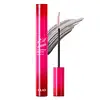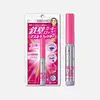What's inside
What's inside
 Key Ingredients
Key Ingredients

 Benefits
Benefits

 Concerns
Concerns

 Ingredients Side-by-side
Ingredients Side-by-side

Isododecane
EmollientTrimethylsiloxysilicate
EmollientCeresin
Emulsion StabilisingPolyisobutene
Talc
AbrasiveDextrin Palmitate/Ethylhexanoate
EmulsifyingDisteardimonium Hectorite
StabilisingMicrocrystalline Wax
Emulsion StabilisingCI 77499
Cosmetic ColorantSilica
AbrasivePropylene Carbonate
SolventHydrogenated Polyisobutene
EmollientPolypropylsilsesquioxane
Cellulose
AbsorbentGlyceryl Caprylate
EmollientTrimethoxycaprylylsilane
SmoothingPolymethylsilsesquioxane
CI 77891
Cosmetic ColorantCI 77492
Cosmetic ColorantCI 77491
Cosmetic ColorantDextrin Palmitate
EmulsifyingParaffin
PerfumingSilica Silylate
EmollientRayon
Ethylene/Propylene Copolymer
AbrasiveWater
Skin ConditioningPanthenol
Skin ConditioningBHT
AntioxidantPhenoxyethanol
PreservativeCI 77266
Cosmetic ColorantCandida Bombicola/Glucose/Methyl Rapeseedate Ferment
AntimicrobialArgania Spinosa Kernel Oil
EmollientCamellia Sinensis Seed Oil
HumectantOlea Europaea Fruit Oil
MaskingHydrolyzed Collagen
EmollientLactobacillus/Soybean Extract Ferment Filtrate
Skin ConditioningNylon-66
Dipropylene Glycol
HumectantAluminum Distearate
Emulsion StabilisingVp/Eicosene Copolymer
Isododecane, Trimethylsiloxysilicate, Ceresin, Polyisobutene, Talc, Dextrin Palmitate/Ethylhexanoate, Disteardimonium Hectorite, Microcrystalline Wax, CI 77499, Silica, Propylene Carbonate, Hydrogenated Polyisobutene, Polypropylsilsesquioxane, Cellulose, Glyceryl Caprylate, Trimethoxycaprylylsilane, Polymethylsilsesquioxane, CI 77891, CI 77492, CI 77491, Dextrin Palmitate, Paraffin, Silica Silylate, Rayon, Ethylene/Propylene Copolymer, Water, Panthenol, BHT, Phenoxyethanol, CI 77266, Candida Bombicola/Glucose/Methyl Rapeseedate Ferment, Argania Spinosa Kernel Oil, Camellia Sinensis Seed Oil, Olea Europaea Fruit Oil, Hydrolyzed Collagen, Lactobacillus/Soybean Extract Ferment Filtrate, Nylon-66, Dipropylene Glycol, Aluminum Distearate, Vp/Eicosene Copolymer
Isododecane
EmollientTrimethylsiloxysilicate
EmollientQuaternium-18 Hectorite
Propylene Carbonate
SolventHydrogenated Glyceryl Dehydroabietate/Tetrahydroabietate
Skin ProtectingDextrin Palmitate
EmulsifyingPrunus Amygdalus Dulcis Oil
Skin ConditioningCamellia Seed Oil
Argania Spinosa Kernel Oil
EmollientRosa Canina Fruit Oil
EmollientPanax Ginseng Root Extract
EmollientRoyal Jelly Extract
Skin ConditioningCeresin
Emulsion StabilisingSucrose Tristearate
EmollientAluminum Distearate
Emulsion StabilisingTrimethylsiloxysilylcarbamoyl Pullulan
Glyceryl Isostearate
EmollientPolymethylsilsesquioxane
Hydrogenated Polyisobutene
EmollientSqualane
EmollientSilica
AbrasiveAluminum PCA
AstringentIsododecane, Trimethylsiloxysilicate, Quaternium-18 Hectorite, Propylene Carbonate, Hydrogenated Glyceryl Dehydroabietate/Tetrahydroabietate, Dextrin Palmitate, Prunus Amygdalus Dulcis Oil, Camellia Seed Oil, Argania Spinosa Kernel Oil, Rosa Canina Fruit Oil, Panax Ginseng Root Extract, Royal Jelly Extract, Ceresin, Sucrose Tristearate, Aluminum Distearate, Trimethylsiloxysilylcarbamoyl Pullulan, Glyceryl Isostearate, Polymethylsilsesquioxane, Hydrogenated Polyisobutene, Squalane, Silica, Aluminum PCA
 Reviews
Reviews

Ingredients Explained
These ingredients are found in both products.
Ingredients higher up in an ingredient list are typically present in a larger amount.
We don't have a description for Aluminum Distearate yet.
You may know this ingredient as argan oil. Argan Oil has antioxidant, hydrating, and soothing properties.
Studies have shown argan oil can help fight again radical damage from the sun. This makes it effective at preventing hyperpigmentation.
Large amounts of vitamin E found in argan oil helps the skin retain water. Argan oil also contains fatty acids such as linoleic acid, oleic acid, and palmitic acid. It is also a good source of lipids.
Another benefit of argan oil is skin-soothing. It can help reduce inflammation-related skin symptoms.
Argan Oil is effective at regulating sebum production in pores. This can make it effective at treating hormonal acne.
Traditionally, argan oil was used for its antibacterial and antifungal properties. However, argan oil contains fatty acids that may make it not fungal-acne safe.
Argan Trees are native to Morocco.
Learn more about Argania Spinosa Kernel OilCeresin is a wax derived from ozokerite. It is an alternative to beeswax.
The most common process of creating ceresin is by using heat and sulfuric acid.
Dextrin Palmitate comes from the palmitic acid ester of Dextrin. It is used as an emulsifier and texture enhancer.
Emulsifiers help keep ingredients together. According to a manufacturer, dextrin palmitate helps create a low-viscosity gel texture.
Due to its fatty acid base, this ingredient is not fungal-acne safe.
Learn more about Dextrin PalmitateHydrogenated Polyisobutene is a synthetic polymer. Polymers are compounds with high molecular weight. Hydrogenated Polyisobutene is an emollient and texture enhancer.
In one study, Hydrogenated Polyisobutene showed better skin hydration levels than Caprylic/Capric Triglyceride. As an emollient, it helps keep your skin soft and hydrated by trapping moisture in.
Hydrogenated Polyisobutene is often used as a mineral oil replacement.
Learn more about Hydrogenated PolyisobuteneIsododecane is a fragrance, emollient, and solvent.
As an emollient, it helps your skin stay soft and hydrated. Emollients help trap moisture into your skin.
Isododecane's role as a solvent makes it a great texture enhancer. It spreads smoothly on skin and does not leave a sticky feeling behind. Isododecane also helps prevent color transfer in makeup products.
Isododecane is not absorbed into skin.
Learn more about IsododecanePolymethylsilsesquioxane is a silicone used as a film forming agent.
When applied to the skin, this ingredient creates an invisible film on the surface. This film still allows oxygen to pass through, but prevents moisture from escaping. This can help condition and hydrate the skin. It also leaves a silky feel when applied.
Polymethylsilsesquioxane has not been shown to clog pores. It has been deemed safe to use up to 55%, but most cosmetics use much less.
If you have concerns about using this ingredient, we recommend speaking with a professional.
Learn more about PolymethylsilsesquioxaneThis ingredient is a solvent. It helps dissolve active ingredients and alter the texture of products.
Propylene Carbonate is commonly used in makeup and with clay, such as montmorillonite or bentonite.
Studies show this ingredient to be safe for cosmetics. When it is undiluted, it can cause skin irritation. (It is always diluted in skincare and makeup). This ingredient is water-soluble.
Propylene Carbonate is created from propylene glycol and carbonic acid.
Learn more about Propylene CarbonateSilica, also known as silicon dioxide, is a naturally occurring mineral. It is used as a fine, spherical, and porous powder in cosmetics.
Though it has exfoliant properties, the function of silica varies depending on the product.
The unique structure of silica enhances the spreadability and adds smoothness, making it a great texture enhancer.
It is also used as an active carrier, emulsifier, and mattifier due to its ability to absorb excess oil.
In some products, tiny microneedles called spicules are made from silica or hydrolyzed sponge. When you rub them in, they lightly polish away dead skin layers and enhance the penetration of active ingredients.
Learn more about SilicaThis silicone is an emollient. Emollients create a thin film on the skin to prevent moisture from escaping.
It is not soluble in water and helps increase water-resistance in products.
According to a manufacturer, it can blend seamlessly with silicone oils, such as Cyclopentasiloxane.
Learn more about Trimethylsiloxysilicate